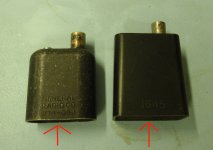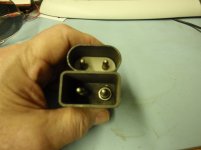I was looking at amplates.com too. They have a .040" thickness anodized aluminum option. That thickness would probably be perfect in replacing the washers behind the shaft nuts.
If I get a chance I'll try and come up with a CAD drawing of the plate this week.
If I get a chance I'll try and come up with a CAD drawing of the plate this week.
Duke, Demian, or Anyman,
Can someone post a pic of the female end of these connectors?
I see the BNC end but no one seems to show the receptacle end.
Thanks for the pics.
Those are pretty Large connectors.
Cheers,
Can someone post a pic of the female end of these connectors?
I see the BNC end but no one seems to show the receptacle end.
Thanks for the pics.
Those are pretty Large connectors.
Cheers,
Hi Sync
I don't know what you are asking for?
The adapter is a DUAL BANANA MALE to FEMALE BNC with a metal shield. I show how to use this adapter with a FLUSH DUAL BANANA FEMALE by extending the male pins by using a Pomona MDP (RED MDP) in the picture.
I hope this helps.
Duke🙂
I don't know what you are asking for?
The adapter is a DUAL BANANA MALE to FEMALE BNC with a metal shield. I show how to use this adapter with a FLUSH DUAL BANANA FEMALE by extending the male pins by using a Pomona MDP (RED MDP) in the picture.
I hope this helps.
Duke🙂
There is even a drawing in the cal section of the 339A manual that says to use one of these.
That's how I new of them.
That's how I new of them.
Hi David,
Yes, it was frustrating when I couldn't find any. They are taking the slow route to me, but at long last I'll have that type of adapter.
-Chris
Yes, it was frustrating when I couldn't find any. They are taking the slow route to me, but at long last I'll have that type of adapter.
-Chris
Thank's Duke, that is what I was looking for. 🙂
Just wanted to see what was inside them. Is the outside magnetic?
Or is it a ferrite type that is connected to the ground point.
Cheers,
Just wanted to see what was inside them. Is the outside magnetic?
Or is it a ferrite type that is connected to the ground point.
Cheers,
Hi Sync
The GR is drawn alum can. The POMONA is a poured alum or pot metal.
I have seen several version of this type of shield on dual bananas. I have seen some with steel, brass and copper that were hand made.
Duke🙂
The GR is drawn alum can. The POMONA is a poured alum or pot metal.
I have seen several version of this type of shield on dual bananas. I have seen some with steel, brass and copper that were hand made.
Duke🙂
Just wondering has anyone ever looked into extending the range of the 339A with a -90dB distortion step. With all of the tweaks to improve the noise floor it seems having a further step down to -90dB would be nice if it was easy to implement. It would be slick to be able to switch between -80 and -90. What got me thinking about this is that I bought an Amber 3501 recently and having the lower distortion ranges that the Amber offers makes it a bit nicer to use when measuring something at the bottom of the range.
KC,
That is an interesting throught. I'm wonder if this can be done on the switches
alone? This could be tricky though. We'd have to either move the caps and
resistors down one tab on the switch terminals and add the correct values for
the -90 dB location. OR delete -80 and place the -90 values there.
Anyone else have thoughts about this?
Cheers,
That is an interesting throught. I'm wonder if this can be done on the switches
alone? This could be tricky though. We'd have to either move the caps and
resistors down one tab on the switch terminals and add the correct values for
the -90 dB location. OR delete -80 and place the -90 values there.
Anyone else have thoughts about this?
Cheers,
Wouldn't it make more sense to delete the -10dB level and shift everything up? All the lower levels become more important as you go down. If you need the -10dB scale, you could just eyeball the distortion on the 'scope.
-Chris
-Chris
I had thought about moving everything up, it just seemed like more work. Especially if you want to mark the distortion knob to match the new range settings. It might be what's needed to do this though.
Try hanging an AC voltmeter on the monitor output and make sure the SNR is low enough for this to work. I'm currently using a good AC voltmeter (Kenwood) on the monitor output of a Shibasoku 725 because the THD+N falls off the bottom of the internal scale at -90. The external meter gets me down to -116 with -110 FS. That's pretty much SOTA today. Playing games with scales and steps can become really confusing. Getting the divider resistors right with such a change is also confusing.
Another option (borrowed from the 725) would be a +10 dB switch. A toggle switch and a 10 dB amp in front of the meter circuit you can switch in when you need it. Get an illuminated switch so you know when its engaged.
Another option (borrowed from the 725) would be a +10 dB switch. A toggle switch and a 10 dB amp in front of the meter circuit you can switch in when you need it. Get an illuminated switch so you know when its engaged.
We could use the "AM" position on the switch for the ground, or use the AM input jack for the hole to mount another switch.
Moving the entire scale up to exclude the 100% range might make the best sense. A new overlay could be justified. My only issue with losing the top ranges are for voltage measurements with high level signals.
-Chris
Moving the entire scale up to exclude the 100% range might make the best sense. A new overlay could be justified. My only issue with losing the top ranges are for voltage measurements with high level signals.
-Chris
A 10dB amp would be nice and tied to the front panel AM switch like anatech has suggested would be cool. Of course we could just take the easy way out and hang a meter on the monitor out Demian is doing.
Ah Demian, Did you have any mods for the Meter Circuit in the
Shibasoku 725, before you could get low enough meter readings
on the AC meter? What the sensitivity (Ohms/volt) of the external
meter? Just curious.
Always interesting stuff going on. Good thinking.
Cheers,
Shibasoku 725, before you could get low enough meter readings
on the AC meter? What the sensitivity (Ohms/volt) of the external
meter? Just curious.
Always interesting stuff going on. Good thinking.
Try hanging an AC voltmeter on the monitor output and make sure the SNR is low enough for this to work. I'm currently using a good AC voltmeter (Kenwood) on the monitor output of a Shibasoku 725 because the THD+N falls off the bottom of the internal scale at -90. The external meter gets me down to -116 with -110 FS. That's pretty much SOTA today. Playing games with scales and steps can become really confusing. Getting the divider resistors right with such a change is also confusing.
Cheers,
Sync,
The monitor out is a 1V scaled reading so with the knob set to -80dB taking a reading from the monitor out would result in 330mV for -90dB and 100mV for -100dB. The meter should be able resolve well below 100mV with a measurement bandwidth equal to that of the HP 339A, so 110kHz.
The monitor out is a 1V scaled reading so with the knob set to -80dB taking a reading from the monitor out would result in 330mV for -90dB and 100mV for -100dB. The meter should be able resolve well below 100mV with a measurement bandwidth equal to that of the HP 339A, so 110kHz.
- Home
- Design & Build
- Equipment & Tools
- HP339A distortion analyser

